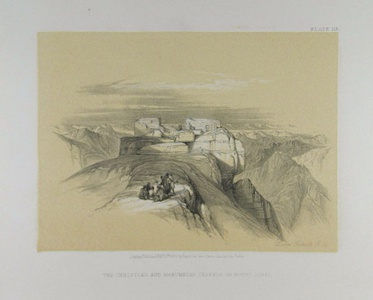| Method | Lithograph with tint stone |
| Artist | after David Roberts |
| Published | London, Published Feby. 15th 1856, by Day & Son, Gate Street, Lincoln's Inn Fields |
| Dimensions | Image 125 x 172 mm, Sheet 192 x 285 mm |
| Notes |
Plate 113 from Volume 3 of the small format reprint of Roberts' The Holy Land, Syria, Idumea, Arabia, Egypt & Nubia. A view of the ruins of the chapels on the summit of Mount Sinai, Egypt. Mount Sinai is an important sacred site for all of the Abrahamic religions, due to its many connections with Moses and the Exodus. The peak still plays host to a mosque and a Greek Orthodox chapel, though at the time of Roberts' visit, both were ruinous. The Orthodox chapel encloses an outcrop of rock that tradition equates with the source for the stone tablets of the Ten Commandments. Nearby, the 'Cave of Moses' is believed to have been the place where Moses waited to receive the commandments. David Roberts RA (24th October 1796 – 25th November 1864) was a Scottish painter. He is especially known for a prolific series of detailed prints of Egypt and the Near East produced during the 1840s from sketches made during long tours of the region (1838-1840). This work, and his large oil paintings of similar subjects, made him a prominent Orientalist painter. He was elected as a Royal Academician in 1841. The firm of Day & Haghe was one of the most prominent lithographic companies of the nineteenth-century. They were also amongst the foremost pioneers in the evolution of chromolithography. The firm was established in 1823 by William Day, but did not trade under the moniker of Day & Haghe until the arrival of Louis Haghe in 1831. In 1838, Day & Haghe were appointed as Lithographers to the Queen. However, and perhaps owing to the fact that there was never a formal partnership between the two, Haghe left the firm in the 1850's to devote himself to watercolour painting. The firm continued as Day & Son under the guidance of William Day the younger (1823 - 1906) but, as a result of a scandal involving Lajos Kossuth, was forced into liquidation in 1867. Vincent Brookes bought the company in the same year, and would produce the caricatures for Gibson Bowles' Vanity Fair magazine, as well as the illustrations for Cassells's Poultry Book, amongst other commissions. Condition: Light foxing to margins, not affecting image. |
| Framing | unmounted |
| Price | £25.00 |
| Stock ID | 39016 |

